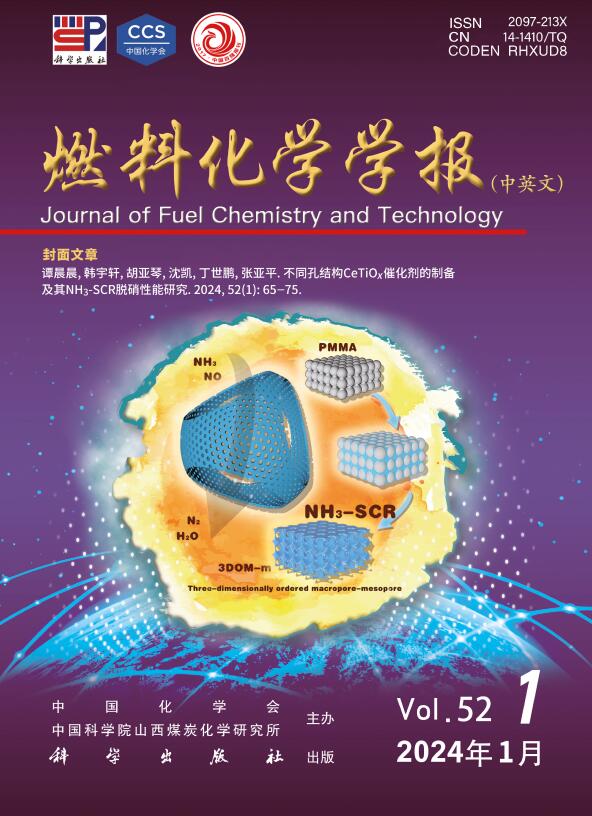痕量KOH催化CO2活化制备生物炭与KOH活化作为碳捕集先进候选物的研究
Q3 Energy
引用次数: 0
摘要
固体废弃物生物质绿色宏观转化制备高品质活性炭的技术急需发展。提出了一种利用微量koh催化CO2活化合成碳吸附剂的方法。从生物炭的理化结构演化、微量koh促进CO2活化过程的机理认识、CO2吸附的应用特性三个方面进行了综合研究。结果表明,微量KOH (<10%)和CO2活化的生物炭比表面积(1244.09 m2/g)与100% KOH活化的生物炭比表面积(1425.10 m2/g)相当。孔结构特征(比表面积和孔体积)受CO和CH4的控制,CO和CH4是由k盐催化CO2与生物炭反应生成的。KBC吸附剂的最佳CO2吸附量分别为4.70 mmol/g(0℃)和7.25 mmol/g(25℃),是同类碳吸附剂中的最大值。5%KBC-CO2样品在不同条件下的CO2吸附量分别为3.19和5.01 mmol/g,达到目前的平均性能水平。值得注意的是,在0.02 bar条件下,CO2/N2选择性(85:15,体积比)达到64.71,具有良好的循环稳定性。分子动力学模拟结果表明,含氧官能团加速了CO2吸附动力学,提高了微孔存储容量。该技术路线具有简单性、环境兼容性和可扩展性,为大规模制备高质量碳材料提供了重要参考。本文章由计算机程序翻译,如有差异,请以英文原文为准。
Research on biochar prepared by trace KOH catalyzed CO2 activation vs KOH activation as advanced candidate for carbon capture
The technology for green and macro-conversion of solid waste biomass to prepare high-quality activated carbon demands urgent development. This study proposes a technique for synthesizing carbon adsorbents using trace KOH-catalyzed CO2 activation. Comprehensive investigations were conducted on three aspects: physicochemical structure evolution of biochar, mechanistic understanding of trace KOH-facilitated CO2 activation processes, and application characteristics for CO2 adsorption. Results demonstrate that biochar activated by trace KOH (<10%) and CO2 achieves comparable specific surface area (1244.09 m2/g) to that obtained with 100% KOH activation (1425.10 m2/g). The pore structure characteristics (specific surface area and pore volume) are governed by CO and CH4 generated through K-salt catalyzed reactions between CO2 and biochar. The optimal CO2 adsorption capacities of KBC adsorbent reached 4.70 mmol/g (0 °C) and 7.25 mmol/g (25 °C), representing the maximum values among comparable carbon adsorbents. The 5%KBC-CO2 sample exhibited CO2 adsorption capacities of 3.19 and 5.01 mmol/g under respective conditions, attaining current average performance levels. Notably, CO2/N2 selectivity (85:15, volume ratio) reached 64.71 at 0.02 bar with robust cycling stability. Molecular dynamics simulations revealed that oxygen-containing functional groups accelerate CO2 adsorption kinetics and enhance micropore storage capacity. This technical route offers simplicity, environmental compatibility, and scalability, providing critical references for large-scale preparation of high-quality carbon materials.
求助全文
通过发布文献求助,成功后即可免费获取论文全文。
去求助
来源期刊

燃料化学学报
Chemical Engineering-Chemical Engineering (all)
CiteScore
2.80
自引率
0.00%
发文量
5825
期刊介绍:
Journal of Fuel Chemistry and Technology (Ranliao Huaxue Xuebao) is a Chinese Academy of Sciences(CAS) journal started in 1956, sponsored by the Chinese Chemical Society and the Institute of Coal Chemistry, Chinese Academy of Sciences(CAS). The journal is published bimonthly by Science Press in China and widely distributed in about 20 countries. Journal of Fuel Chemistry and Technology publishes reports of both basic and applied research in the chemistry and chemical engineering of many energy sources, including that involved in the nature, processing and utilization of coal, petroleum, oil shale, natural gas, biomass and synfuels, as well as related subjects of increasing interest such as C1 chemistry, pollutions control and new catalytic materials. Types of publications include original research articles, short communications, research notes and reviews. Both domestic and international contributors are welcome. Manuscripts written in Chinese or English will be accepted. Additional English titles, abstracts and key words should be included in Chinese manuscripts. All manuscripts are subject to critical review by the editorial committee, which is composed of about 10 foreign and 50 Chinese experts in fuel science. Journal of Fuel Chemistry and Technology has been a source of primary research work in fuel chemistry as a Chinese core scientific periodical.
 求助内容:
求助内容: 应助结果提醒方式:
应助结果提醒方式:


